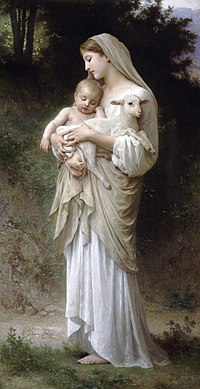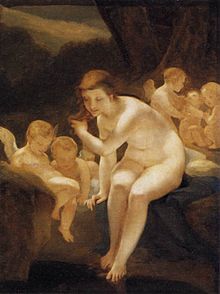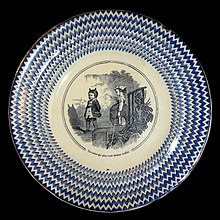Innocence


Innocenceis a lack ofguilt,with respect to any kind ofcrime,or wrongdoing. In alegal context,innocence is the lack oflegal guiltof an individual, with respect to a crime. In other contexts, it is a lack of experience.
In relation to knowledge
[edit]Innocence can imply lesserexperiencein either a relative view to social peers, or by an absolute comparison to a more common normative scale. In contrast toignorance,it is generally viewed as a positive term, connoting anoptimisticview of the world, in particular one where the lack of wrongdoing stems from a lack of Knowledge, whereas wrongdoing comes from a lack of knowledge in children. Subjects such ascrimeandsexualitymay be especially considered. This connotation may be connected with a popularfalse etymologyexplaining "innocent" as meaning "not knowing" (Latinnoscere— to know, learn). The actual etymology is from general negation prefixin-and the Latinnocere,"to harm".
People who lack the mental capacity to understand the nature of their acts may be regarded as innocent regardless of their behavior. From this meaning comes the usage ofinnocentas a noun to refer to a child under theage of reason,or a person, of any age, who is severelymentally disabled.
Jean-Jacques Rousseaudescribed "childhood as a time of innocence" where children are "not-knowing" and must reach the age of reason to become competent people in society. However, as technology advances, children in the contemporary world have a platform where they are referred to as "digital natives", where they appear to be more knowledgeable in some areas than adults.[1]
Pejorative meaning
[edit]"Innocence" can have apejorativemeaning, in cases where an assumed level of experience dictates common discourse or baseline qualifications for entry into another, different, social experience. Since experience is a prime factor in determining a person's, innocence is often also used to implynaivetyor lack of experience.
Symbolism
[edit]
Thelambis a commonly used symbol of innocence. InChristianity,for example,Jesusis referred to as the "Lamb of God", thus emphasizing his sinless nature.[2]Other symbols of innocence includechildren,[3]virgins,[3]acaciabranches (especially in Freemasonry),[4][5]non-sexual nudity, songbirds, and the colorwhite(biblical paintings and Hollywood films depict Jesus wearing a white tunic).[6][7]
Loss of innocence
[edit]A "loss of innocence" is a common theme infiction,pop culture,andrealism.It is often seen as an integral part ofcoming of age.It is usually thought of as an experience or period in a person's life that leads to a greater awareness of evil, pain, and/or suffering in the world around them. Examples of this theme include songs like "American Pie",[8]poetry likeWilliam Blake's collectionSongs of Innocence and of Experience,novels likeTo Kill a Mockingbird,The Catcher in the Rye,A Farewell to Arms,andLord of the Flies,and films likeViridiana,The 400 Blows,andStand By Me.
By contrast, theI Chingurges a recovery of innocence – the name given toHexagram 25– and "encourages you toactively practice innocence".[9]
Innocence could also be viewed as a Westernized view of childhood, and the "loss" of innocence is simply a social construction or viewed as the dominant ideology. Thinkers such asJean-Jaques Rousseauused the romanticism discourse as a way to separate children from adults. Ideas surrounding childhood and childhood innocence stem from this discourse.[10]
In psychoanalysis
[edit]Thepsychoanalytictradition is broadly divided between those (likeFairbairnandWinnicott) who saw the child as initially innocent, but liable to lose its innocence under the impact of stress orpsychological trauma;and those (likeFreudandKlein) who saw the child asdevelopinginnocence — maturing into it — as a result of surmounting theOedipus complexand/or the depressive position.[11]
More eclectically,Eric Bernesaw the Child ego state, and its vocabulary, as reflecting three different possibilities: the clichés of conformity; the obscenities of revolt; and "the sweet phrases of charming innocence".[12]Christopher Bollasused the term "Violent Innocence" to describe a fixed and obdurate refusal to acknowledge the existence of an alternative viewpoint[13]— something akin to what he calls "the fascist construction, the outcome is to empty the mind of all opposition".[14]
Literary sidelights
[edit]- InDoris Lessing'sThe Golden Notebook,a woman looks back in laughing envy at the innocence that had previously allowed her to submerge herself in the position of the "woman-in-love".[15]
- Ivy Compton-Burnetthad one character conclude dourly of another two that "you are both of you innocent though it is an innocence rooted in your wishes for your own lives".[16]
See also
[edit]- Beginner's mind– Zen Buddhism concept of the beginner's mind
- Fig leaf covering– Artistic or metaphorical censorship practice
- Gullibility– Failure of social intelligence
- Ingénue– Stock character in literature and media
- Naivety– Lack of experience
- Three wise monkeys– Pictorial maxim, embodying "see no evil, hear no evil, speak no evil"
References
[edit]- ^Boyd, Danah (2014).It's Complicated: the Social Lives of Networked Teens.New Haven: Yale University Press.
- ^Paton, Chalmers I. (1873). "Masonic Symbols—The Lamb".Freemasonry: Its Symbolism, Religious Nature, and Law of Perfection.London: Reeves and Turner. pp. 232–240.
- ^ab"Top 15 Symbols of Innocence With Meanings".Give Me History.January 21, 2022.RetrievedAugust 12,2023.
- ^Heath, Geo. F., ed. (1903).The Numismatist.XVI.American Numismatic Associationhttps://books.google.com/books?id=WpEUAAAAYAAJ.RetrievedFebruary 25,2013.
{{cite journal}}:Missing or empty|title=(help)[page needed] - ^"32 Masonic Symbols (& What They Mean)".MasonicFind.24 October 2022.RetrievedAugust 12,2023.
- ^The Encyclopedia Americana: A Library of Universal Knowledge.Encyclopedia Americana Corporation.1920.RetrievedFebruary 25,2013.[page needed]
- ^"Top 15 Symbols of Innocence With Meanings".Give Me History.January 21, 2022.RetrievedAugust 12,2023.
- ^Levitt, Saul."American Pie by Don McLean".Missamericanpie.co.uk. Archived fromthe originalon 2011-04-05.Retrieved2011-02-16.
- ^The I Ching or Book of Changes.Translated by Walker, B. B. 1993. p. 53.
- ^"Rousseau's Theory Of Childhood Innocence | ipl.org".www.ipl.org.Retrieved2023-08-12.
- ^Symington, N. (1993).Narcissism.pp. xiv–xv.
- ^Berne, E. (1974).What Do You Say After You Say Hello?.p. 325.
- ^Cavanagh, S. (2013).Skin, Culture and Psychoanalysis.p. 137.
- ^Quoted inPhillips, Adam(1994).On Flirtation.p. 158.
- ^Lessing, Doris (1973).The Golden Notebook.p. 216.
- ^Compton-Burnett, I. (1971).The Last and the First.p. 142.
